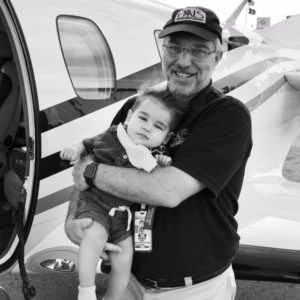
For most GA pilots, flying a passenger who requires supplemental oxygen is probably a rare occurrence. But for volunteer pilots like us, the passengers we fly aren’t your typical, everyday passengers, and they have a variety of needs.
Every now and then when choosing a flight from the PALS Missions Available list, you may come across a note that says “Passenger Traveling with Oxygen”. This might raise some questions for you. Can I legally take O2 on my aircraft? Is this person “too sick” to fly? How big is this thing? What else do I need to consider?
All that uncertainty might even lead you to bypass the flight. But flying a passenger on oxygen isn’t as scary or complex as it may sound.
Here’s what you need to know about flying a passenger who needs supplemental O2:
Medical Concerns
All passengers who travel with PALS are medically stable and approved for flight in a small, non-pressurized aircraft by their physician. Taking into account any medical equipment, the person’s physician has verified that they do not have any medical condition that could affect the safety of the flight or the passenger’s personal health or safety.
If you ever have any questions or concerns about a passenger, for any reason, don’t hesitate to ask a member of the PALS team. They’re there to help you and should be used as a resource.
FAA Compliance
Visions of a person toting a large O2 canister filled with hazardous compressed or liquid oxygen may leave you wondering about the legality of transporting a person with oxygen on board your aircraft.
Generally, the FAA prohibits the use of personal oxygen units during flight because they contain compressed gas or liquid oxygen that is defined as hazardous material. However, the FAA has issued guidelines permitting the onboard use of certain portable oxygen concentrators (POCs).
POCs approved by the FAA may be carried and used on board. All PALS passengers needing oxygen are required to provide it in an FAA approved concentrator.
For more reading on the rule see: 14 CFR 135.91 (e) – Oxygen and portable oxygen concentrators for medical use by passengers
Note: For purposes of this paragraph, an aircraft operator that is not a certificate holder under 14 CFR part 121 or part 135, may apply this exception in conformance with 14 CFR 121.574 or 135.91 in the same manner as required for a certificate holder.
Oxygen Concentrator Sizes Vary

Some are very small and can sit in a passenger’s lap (see right), some can be quite large (see below) and will need to rest on the floor.
Whenever a PALS passenger is traveling with an oxygen concentrator, the PALS staff will provide you with the dimensions and weight for the equipment so you can determine what may or may not work for you and your aircraft. If you’re still unsure, ask for a picture. Most times, the passenger would be happy to provide one or PALS may even have one for your reference.
Stowing and Securing the Equipment

Power Supply and Battery Life
Most passengers will have a POC with batteries that last from 2-4 hours depending on the model.
Most airlines require the battery life for POCs to equal 150% of the flight time and it’s a good rule of thumb to suggest the same to your passenger. So, if it’s a two hour flight, three hours of battery time would be optimum.
When briefing the passengers about your flight you should mention the flight duration so that they can do battery life planning.
Heads up: When batteries get low, there can be an audible alarm that goes off which can be loud. On my checklist now, I am asking if the battery low alarm might go off in flight. I also ask if it can or cannot be turned off. The audible alarm is typically not so loud as to be distracting or disrupt communications with ATC.
There is no requirement for you to provide aircraft electrical power to a POC user but you may do so if you have the appropriate electrical outlets on board and chose to do so.
Planes with Oxygen
Some pilots may have oxygen supply in their aircraft that is passenger-accessible. Even if you do, you should not plan on using that for patients who require a POC. Passengers are responsible for regulating their oxygen levels. That said, you are PIC and should use common sense in assessing the need for changes to your flight, should you feel a passenger is having some kind of distress.
It should go without saying that all PALS Pilots are at liberty to (and should) decline any flight they feel uncomfortable making. But hopefully this information has helped demystify what it’s like to fly a patient on oxygen. Knowing what to expect can go a long way in easing any hesitations you might have had. If you have any additional questions, please feel free to contact me or a member of the PALS team.
About the Author

Mark Hanson is a Commercial Instrument ASEL AMEL ASES pilot with an Eclipse 500 single pilot type rating, flying mostly for fun and PALS. Mark is a member of the Pilot and Safety Committees at PALS, with experience from over 150 PALS missions including flights with a variety of POC devices.
